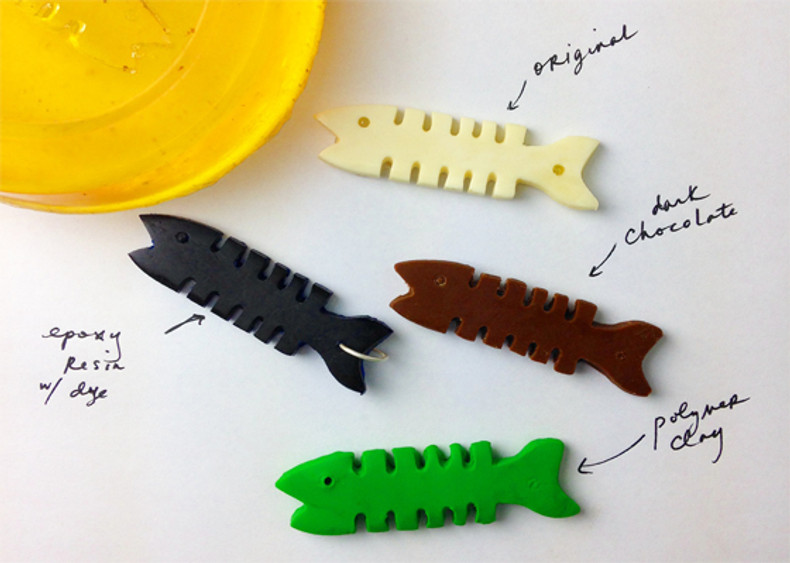So the ComposiMold saying goes like this: Make more molds with 1 pound of ComposiMold than with 30 pounds of other mold making materials. This is because ComposiMold can be re-melted and re-used to make a new mold.
But what about casting materials?
Here we show you 5 recipes of casting materials that you can make yourself and then use to make castings. They are inexpensive and with care can make great castings.
Casting material Recipes:
Paper Mache
Here’s an easy recipe: water, flour, and paper. Watch this video on paper mache casting.
Great for simple 1 part castings. Two part castings may be done as two separate parts that are then put together in segments. Be sure to give each layer enough time to dry. Make the first layer thin and let it dry very well before putting on the next layer. Use cold water also.
Fondant Casting Materials
This is the tastiest casting material (except maybe chocolate!).This recipe is from http://thecookduke.com/fondant-recipe/. And I must say I was very happy with it! One of the few fondants that I could not stop eating it tasted so good. To cast with it. Just push the fondant into the mold like a push mold. The video shows this process:
Ingredients to make the fondant recipe:
o1 Tbsp of unflavored gelatin
o1/4 cup of cold water
o1 tsp of almond extract (I prefer to switch this with vanilla extract)
o1/2 cup of light corn syrup (If a corn syrup is not available, you can substitute it with a sugar syrup made with 1-1/4 cups sugar and 1/3 cup water, boiled together until syrupy)
o1 Tbsp of glycerin (some recipes say it’s optional, believe me, it’s a must)
o2 lbs 10X confectioners’ sugar
o1/2 tsp of white vegetable shortening
Directions how to make the fondant recipe:
oSprinkle the gelatin over cold water in a small bowl and let it rest for 2 minutes to soften
oPlace the bowl in a microwave for 30 seconds on High, until the gelatin dissolves
oAdd the Almond or vanilla extract
oAdd the corn syrup and the glycerin and stir until the mixture is smooth and clear (if the mixture is not turning smooth and clear, microwave it for an additional 15 to 20 seconds on high and stir again)
oSift 1 1/2 pounds of the sugar into a large bowl
oMake a hole in the sugar and pour the liquid mixture to it
oStir with a wooden spoon until the mixture becomes sticky
oSift some of the remaining 1/2 pound of sugar onto a smooth work surface and add as much of the remaining sugar as the mixture will take
oKnead the fondant, adding a little more sugar if necessary, to form a smooth, pliable mass
oRub the vegetable shortening on your thumbs and knead it into the fondant
oWrap the fondant in plastic wrap and place it in a tightly sealed container to prevent it from drying out
oIf the icing dries out and harden it can often be revived by popping it into a microwave oven for a few seconds and then kneading it back to life
Paper Clay or Air Dry Clay.
Paper clay works as an air dry casting material, so you mold it in the ComposiMold and then pull it out to let it dry. This is the same process you use for polymer clay or clay mold making. This is also the same as the fondant castings.
The recipe we really like is from: http://dahlhartlane.blogspot.com/2011/10/how-to-make-paper-clay.html. The process basically combines a the rayon fiber from toilet paper with the plaster from the joint compound and PVA glue.
Ingredients: 2 Cups toilet paper
1 Cup regular joint compound
3/4 Cups paper mache paste or Elmers glue (much cheaper to use your own paste).
3/4 Cups flour
Mix them all together in a blender and your hands. Keep the remainder covered so it doesn’t dry out.
Plaster Casting:
I add plaster and concrete onto this list of recipes because they are so inexpensive. The Plaster of Paris at the hardware store costs well less than a dollar a pound. Use a 70:30 ratio of plaster to water by weight or thicker. The thicker your plaster mixture, the stronger your casting will be. Tap or vibrate the sides to help pull the bubbles out. Here’s a video showing how to make the molds and castings for the plaster.
Concrete Mold Making and Casting
Also, super cheap casting material. You will be surprised at the detail you can get with concrete and cement. Cement is the limestone part of the concrete. Concrete has the agglomerates such as rock or gravel in it. The cement by itself won’t be as strong as the concrete, but you can mix it with sand or other particles to make a nice finish. Keep the water content as low as possible. See the video below for concrete instructions:
And the best part, is you can keep on experimenting with ComposiMold molds!
"ComposiMold's greatest advantage is it's reusability".
For More Information visit our Learn Mold making page
www.Facebook.com/ComposiMold
www.YouTube.com/ComposiMold
Free E-Book at http://composimoldstore.com/free-e-books/


